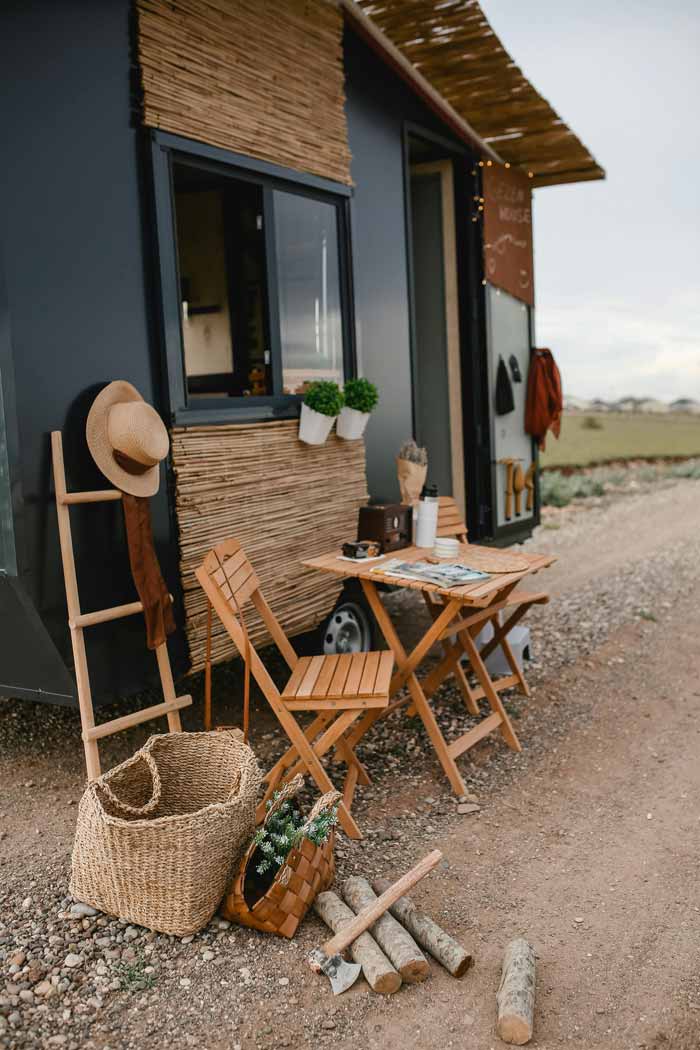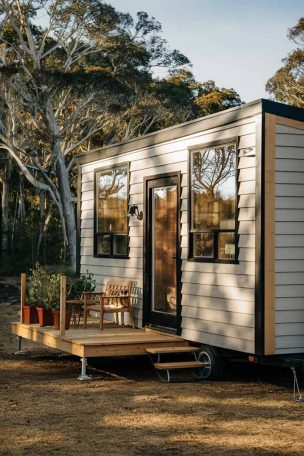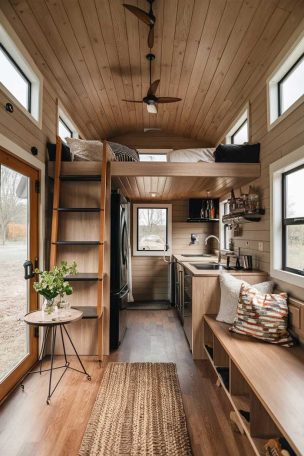In recent years, the tiny house movement has gained significant traction, with more and more people embracing the idea of downsizing their living spaces. At the forefront of this trend is the Tiny House on Wheels (THOW), a unique and versatile dwelling that’s capturing the imagination of adventurers, minimalists, and eco-conscious individuals alike.
But what is a tiny house on wheels, and why is it becoming such a popular choice? Let’s dive in and explore this fascinating concept in detail.
A tiny house on wheels is exactly what it sounds like – a small, mobile dwelling built on a trailer chassis that can be towed by a vehicle. These compact homes typically measure between 100 and 400 square feet, offering a cozy and efficient living space that challenges traditional notions of what a home should be.
THOWs are more than just glorified campers or RVs. They’re carefully designed and constructed to maximize every inch of space, often incorporating clever storage solutions and multi-functional furniture. The result is a fully functional home that just happens to be on wheels.
Definition and Basic Characteristics
The key defining feature of a THOW is its mobility. Unlike traditional tiny houses built on foundations, these homes can be hitched to a vehicle and moved to new locations. This mobility offers a unique blend of freedom and flexibility that’s hard to find in conventional housing options.
THOWs are built to last, using high-quality materials and construction techniques that can withstand the rigors of travel. They’re designed to be functional and comfortable, with all the amenities you’d expect in a traditional home, just in a more compact package.
Key Dimensions
When it comes to size, THOWs have to strike a balance between livability and mobility. Here are the typical dimensions you can expect:
- Length: Most THOWs max out at about 12.5 meters (40 feet) long. However, some jurisdictions allow up to 16.15 meters (53 feet) when you include the towing vehicle.
- Width: The standard maximum width is 2.5 meters. While you might be tempted to go wider for more interior space, be cautious – anything over 3 meters wide can lead to registration and legal issues in many areas.
- Height: THOWs typically top out at 4.3 meters tall. This height limit ensures they can clear most bridges and overpasses when being towed.
- Square Footage: While THOWs can range from 60 to 400 square feet, most fall under 200 square feet. This smaller size makes them easier to tow and more maneuverable on the road.
These dimensions are crucial to keep in mind if you’re considering a THOW. They not only affect your living space but also determine where and how you can travel with your home.
Benefits of Tiny Houses on Wheels
Now that we’ve covered the basics let’s explore why so many people are drawn to the THOW lifestyle. There are several compelling benefits that make these compact homes an attractive option for a wide range of individuals.
1. Financial Freedom
One of the most significant advantages of a THOW is the potential for greater financial freedom. Here’s how these tiny homes can impact your wallet:
- Lower upfront costs: Compared to traditional homes, THOWs are significantly less expensive to purchase or build. This lower initial investment can make homeownership more accessible for many people.
- Reduced ongoing expenses: The compact size of a THOW translates to smaller utility bills. You’ll use less energy for heating, cooling, and lighting. Plus, in most cases, you won’t have to pay property taxes, which can lead to substantial savings over time.
- Greater financial flexibility: With lower housing costs, THOW owners often find they have more disposable income or the ability to save and invest for the future.
This financial advantage can be life-changing, allowing people to pursue passions, travel more, or simply live with less financial stress.
2. Mobility and Flexibility
The “on wheels” part of a THOW isn’t just for show – it’s a key feature that offers unparalleled flexibility:
- Easy relocation: Whether you’re chasing better weather, new job opportunities, or just a change of scenery, a THOW allows you to pick up and move with relative ease.
- Changing environments: For those who get restless staying in one place, a THOW provides the opportunity to experience different locations without the hassle of selling a home and buying a new one.
- Off-grid potential: With the right setup, including solar panels and water collection systems, a THOW can enable true off-grid living. This opens up a world of possibilities for where you can park and live.
This mobility can be especially appealing for digital nomads, retirees, or anyone who values the freedom to change their surroundings without uprooting their entire life.
3. Simplified Lifestyle
Living in a THOW often leads to a simpler, more intentional way of life:
- Encourages minimalism: With limited space, you’re forced to think carefully about what you really need and value. This can lead to a less cluttered, more purposeful living environment.
- Promotes stress-free living: Fewer possessions often mean less to worry about and maintain. Many THOW owners report feeling a sense of liberation from “stuff.”
- Smaller environmental footprint: THOWs use fewer resources to build and maintain, and their small size naturally leads to lower energy consumption. For the environmentally conscious, this can be a significant draw.
This simplified lifestyle isn’t for everyone, but for those who embrace it, it can lead to a more focused, less stressful way of living.
Challenges and Considerations
While the benefits of THOWs are numerous, it’s important to acknowledge that this lifestyle comes with its own set of challenges. Being aware of these potential hurdles can help you make an informed decision about whether a THOW is right for you.
Space Limitations
The most obvious challenge of living in a THOW is the limited space:
- Restricted living and storage areas: You’ll need to be creative with storage solutions and be willing to live with less stuff. This can be a significant adjustment for those used to larger homes.
- Requires creative space-saving solutions: From multi-functional furniture to clever built-ins, maximizing space in a THOW often requires innovative design solutions.
While some people thrive in compact spaces, others may find it claustrophobic or frustrating. It’s essential to honestly assess your space needs and comfort level with minimalist living before committing to a THOW.
Legal and Regulatory Hurdles
One of the biggest challenges facing THOW owners is navigating the complex legal landscape:
- Zoning laws vary by location: Many areas have zoning laws that don’t account for THOWs, making it difficult to find legal places to park long-term.
- RV classification issues: THOWs are often classified as RVs, which can create problems for those wanting to use them as permanent residences. Many jurisdictions have restrictions on how long an RV can be occupied in one place.
- Lack of unified standards: There’s no universal building code for THOWs, which can make it challenging to ensure your home meets local requirements wherever you go.
These legal grey areas mean that THOW owners often need to do extensive research and potentially advocate for changes in local laws to make their lifestyle work.
Comparison to Traditional RVs
While THOWs share some similarities with RVs, there are important differences to consider:
- Customization: THOWs offer more customization options, allowing you to create a space that truly feels like home.
- Living space: Generally, THOWs provide more living space than standard RVs, with layouts designed for full-time living rather than occasional use.
- Travel readiness: THOWs are less suited for frequent, long-distance travel compared to RVs. They’re built more for occasional moves rather than constant travel.
Understanding these differences can help you decide whether a THOW or a traditional RV better suits your needs and lifestyle goals.
Key Features to Consider When Buying
If you’re seriously considering a THOW, there are several key features you’ll want to pay attention to. These factors can significantly impact your comfort, the home’s durability, and your overall satisfaction with tiny house living.
1. Construction and Materials
The quality of construction and choice of materials are crucial for a THOW:
- Lightweight, durable materials: Since your home needs to be towable, it’s important to use materials that are both light and strong. This often includes aluminum framing, lightweight wood products, and high-tech insulation materials.
- High-quality craftsmanship: Your home will be subjected to the stresses of travel, so solid construction is essential. Look for homes built by experienced tiny house builders who understand the unique requirements of mobile structures.
- Proper insulation and ventilation: Good insulation is crucial for maintaining comfortable temperatures and reducing energy costs. Equally important is proper ventilation to prevent moisture build-up and maintain air quality in a small space.
Don’t skimp on these elements – they’re fundamental to creating a comfortable, long-lasting home.
2. Mobility Factors
Since the ability to move is a key feature of THOWs, pay close attention to mobility-related features:
- Specialized trailer chassis: THOWs should be built on trailers specifically designed for tiny houses, not regular utility trailers. These specialized trailers are engineered to handle the weight and provide a stable platform for your home.
- Compliance with regulations: Ensure your THOW meets local trailer size and weight regulations. This may vary depending on where you plan to travel or live.
- Ease of hitching and towing: Consider how easily the home can be prepared for travel. Some THOWs are designed with quick-disconnect utilities and easy-to-use leveling systems to make moves less of a hassle.
Remember, even if you don’t plan to move often, the ability to do so is part of what makes a THOW unique.
3. Off-Grid Capabilities
For many THOW enthusiasts, the ability to live off-grid is a major draw. Here are some features to consider:
- Solar panel options: Many THOWs come with pre-installed solar panels or are solar-ready. This can provide the electricity you need without being tied to the grid.
- Rainwater collection systems: Some THOWs incorporate rainwater harvesting systems, allowing you to collect and use rainwater for various purposes.
- Composting toilets: These eco-friendly toilets can significantly reduce your water usage and allow for more flexibility in where you can park your THOW.
These features can greatly enhance your ability to live independently and reduce your environmental impact.
4. Customization Options
One of the joys of a THOW is the ability to customize it to your needs and preferences:
- Flexible floor plans: Look for designs that make the most of the limited space. This might include loft bedrooms, multi-functional areas, or clever storage solutions.
- Full kitchen and bathroom designs: Just because the space is small doesn’t mean you have to compromise on functionality. Many THOWs include impressively equipped kitchens and bathrooms.
- Personal touches: Consider how you can incorporate your personal style into the design. From choice of materials to color schemes, your THOW should reflect your personality.
Remember, the goal is to create a space that feels like home, no matter how small it may be.
Where to Park a Tiny House on Wheels
One of the most common questions potential THOW owners have is, “Where can I park my tiny house?” It’s a crucial consideration, as even the most perfect tiny house isn’t much use if you have nowhere to put it. Let’s explore some of the most common options.
RV Parks and Campgrounds
RV parks and campgrounds are often the most straightforward option for THOW parking:
- RVIA certification: Many RV parks will accept THOWs that are certified by the Recreation Vehicle Industry Association (RVIA). This certification indicates that the home meets RV construction standards.
- Hookups and amenities: RV parks typically provide electricity, water, and sewer hookups, as well as amenities like laundry facilities and communal spaces.
- Increasing acceptance: Some RV parks are becoming more open to non-RVIA certified tiny houses, recognizing the growing trend. It’s always worth calling ahead to check their policies.
While RV parks can be a great option, keep in mind that they’re often designed for short-term stays and may have restrictions on long-term residency.
Private Land Rentals
Renting space on private property can be an excellent option for THOW owners:
- Flexibility: Landowners may be open to both short-term and long-term arrangements, giving you more flexibility than traditional rental situations.
- Finding opportunities: Look for these opportunities on online classifieds like Craigslist, Facebook Marketplace, or through tiny house-specific communities and forums.
- Building relationships: This option often allows for more personal relationships with landowners, which can lead to more stable, long-term parking situations.
When pursuing this option, be sure to check local zoning laws and get any agreements in writing to protect both you and the landowner.
Tiny House Communities
A growing trend in the THOW world is the development of communities specifically for tiny houses:
- Dedicated spaces: These communities provide lots or pads designed to accommodate THOWs, often with necessary hookups and amenities.
- Community aspect: Living in a tiny house community can provide a sense of belonging and shared experience with like-minded individuals.
- Location trends: These communities are becoming more common in states like California, Oregon, Texas, North Carolina, and Florida, but they’re starting to pop up all over the country.
Tiny house communities can offer the best of both worlds – the freedom of tiny living with the stability of a dedicated location.
Federal Land Options
For those seeking a more off-grid experience, some federal lands may be an option:
- Dispersed camping: Some national forests and Bureau of Land Management (BLM) lands allow dispersed camping, which could accommodate a THOW for short periods.
- Research required: This option requires thorough research and often communication with local authorities to ensure you’re following all regulations.
- Limited amenities: Be prepared for true off-grid living, as these areas typically don’t provide hookups or other amenities.
While this can be an appealing option for adventure seekers, it’s generally not suitable for long-term living and comes with its own set of challenges.
Accessory Dwelling Units (ADUs)
In some areas, THOWs can be classified as Accessory Dwelling Units:
- Zoning allowances: Some jurisdictions are updating their zoning laws to allow THOWs as ADUs on residential properties.
- Permanent solution: This option can provide a more permanent parking solution, often in residential areas.
- Relationship to main property: ADUs are typically required to be secondary to a main dwelling on the property, so this often involves renting space from a homeowner.
The ADU option is becoming more common as cities look for creative solutions to housing shortages, but availability varies widely by location.
Legal Classification and Implications
Understanding the legal status of THOWs is crucial for anyone considering this lifestyle. The legal landscape can be complex and varies significantly from one jurisdiction to another.
RV Classification
In most areas, THOWs are legally classified as a type of RV:
- Certification standards: Many THOWs are built to meet RV Industry Association (RVIA) standards, which allows them to be certified as RVs.
- Registration and insurance: This classification allows THOWs to be registered and insured like RVs, which can be both a benefit and a limitation.
- VIN numbers: Like RVs, THOWs typically have Vehicle Identification Numbers (VINs), further solidifying their status as vehicles rather than structures.
While this classification solves some legal issues, it creates others, particularly when it comes to using a THOW as a permanent residence.
Regulatory Challenges
The RV classification of THOWs leads to several regulatory challenges:
- Residence restrictions: Many local ordinances don’t allow RVs to be used as full-time, permanent residences. This can create legal grey areas for THOW dwellers.
- Inconsistent definitions: Different jurisdictions may have varying definitions of what constitutes a tiny house, an RV, or a permanent structure. This lack of consistency can make it difficult to know how your THOW will be classified from one area to another.
- Evolving regulations: As tiny houses become more popular, many areas are working to update their regulations. However, this process is slow and can lead to uncertainty in the meantime.
Navigating these challenges often requires THOW owners to be well-informed and sometimes to advocate for changes in local regulations.
Conclusion
Tiny Houses on Wheels represent a unique and exciting approach to housing that offers a blend of mobility, affordability and simplified living. They challenge traditional notions of what a home should be and provide an alternative for those seeking a different way of life.
However, embracing the THOW lifestyle isn’t without its challenges. From space limitations to legal hurdles, potential tiny house dwellers need to consider all aspects of this lifestyle choice carefully.
As the tiny house movement continues to grow, we’re likely to see more acceptance and clearer regulations surrounding THOWs. For now, those interested in this lifestyle should be prepared to do their research, be flexible, and potentially advocate for change in their communities.
A Tiny House on Wheels can ultimately offer freedom, financial flexibility, and a chance to live more intentionally. For those willing to embrace the challenges along with the benefits, it can be an incredibly rewarding way of life. Whether you’re looking to downsize, reduce your environmental impact, or simply live life on your own terms, a THOW might be the perfect solution.





